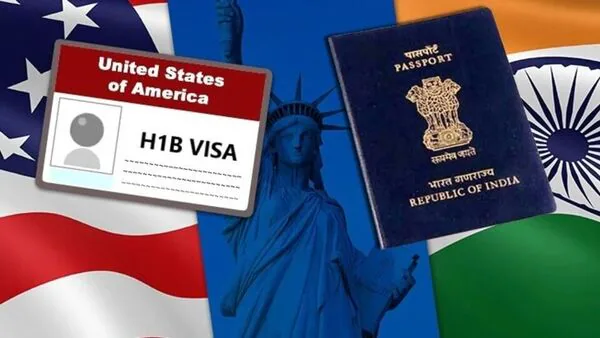The H-1B visa program has long been a cornerstone of the economic and technological partnership between India and the United States. Established in 1990 under the U.S. Immigration and Nationality Act, the visa allows U.S. employers to temporarily hire highly skilled foreign professionals in specialty occupations—most commonly in IT, engineering, medicine, research, and finance.
Over the last three decades, this program has profoundly shaped India’s tech workforce and America’s innovation ecosystem, creating a two-way flow of talent and economic benefit. However, recent changes in U.S. immigration and labor policies have altered its impact, generating mixed consequences for both nations.
🌍 Why the H-1B Visa Was Crucial
✅ For the United States
- Talent Shortages Addressed: The U.S. faced a chronic shortage of STEM professionals, particularly in software and emerging technologies. The H-1B program filled this gap.
- Boost to Innovation: Indian professionals contributed to the growth of Silicon Valley giants like Microsoft, Google, Amazon, and countless startups.
- Economic Gains: Studies by the National Foundation for American Policy (NFAP) suggest that immigrant-founded companies created millions of American jobs.
- Competitiveness: By bringing in global talent, the U.S. retained its edge as the world’s tech innovation leader.
✅ For India
- Employment Opportunities Abroad: H-1B visas opened pathways for Indian engineers and scientists to work in high-paying global roles.
- Remittances: Indian H-1B workers sent home billions of dollars in remittances, strengthening India’s foreign exchange reserves.
- Skill Development: Professionals gained exposure to cutting-edge technologies, management practices, and global markets.
- Boom in IT Industry: Indian IT giants like Infosys, TCS, Wipro, and HCL leveraged H-1B to expand their global delivery models.
🔄 Recent Changes in the H-1B Landscape
Over the past few years, the U.S. has introduced stricter measures to regulate the H-1B program:
- Higher Scrutiny: Increased documentation requirements and audits on outsourcing firms.
- Wage Level Reforms: Priority given to higher-paid applicants to reduce perceived misuse by outsourcing companies.
- Reduced Approvals: Declining approval rates and rising rejection rates since the late 2010s.
- Shift to Remote Work: Post-pandemic, many U.S. firms are outsourcing jobs directly to India instead of bringing workers on H-1B.
- Rising Costs for Companies: A controversial proposal now requires employers to pay up to $100,000 in fees per H-1B petition, aimed at discouraging excessive dependency on foreign talent.
📉 Effects on the United States
- Short-Term Talent Gaps: Restrictions created shortages in specialized sectors like AI, chip design, and biotech, slowing projects.
- Higher Labor Costs: The $100k petition fees, combined with wage-level rules, significantly raise the cost of hiring global talent, especially hurting startups and mid-sized firms.
- Outsourcing Surge: Stricter visa rules ironically accelerated offshore outsourcing, moving jobs to India rather than keeping them in the U.S.
- Innovation Risks: If top global talent finds the U.S. less welcoming and unaffordable for employers, countries like Canada, the UK, and Australia gain an edge.
📉 Effects on India
- Reduced Onsite Opportunities: Young Indian engineers now face fewer chances of working in the U.S. compared to the 2000s.
- Shift in Business Models: Indian IT firms are focusing on nearshore centers (Canada, Mexico, Eastern Europe) and remote delivery.
- Brain Circulation Instead of Brain Drain: More Indian professionals are choosing to return home or work from India, fueling the domestic startup ecosystem.
- Upskilling Pressure: With fewer opportunities abroad, Indian professionals must focus more on high-end R&D, AI, and product development at home.
- Cost Advantage for India: The rising U.S. compliance costs ($100k fees) make outsourcing directly to India more attractive for global firms, indirectly benefitting Indian service providers.
⚖️ The Balance Today
- For the U.S., the H-1B program remains vital but increasingly expensive and politically sensitive.
- For India, restrictions and fee hikes reduce individual opportunities but could channel more global work into India itself.
🔮 The Road Ahead
- India–U.S. Tech Partnership: Despite tighter visa rules, India and the U.S. continue to collaborate in semiconductors, AI, green energy, and defense tech.
- Alternative Pathways: Canada’s open tech work permit, the UK’s Global Talent Visa, and Australia’s skilled migration programs are attracting Indian talent who once primarily looked to the U.S.
- Domestic Growth Story: India’s startup ecosystem, now the third-largest in the world, benefits from the return of highly skilled professionals with global exposure.
✍️ Conclusion
The H-1B visa was once a one-way highway for Indian talent to fuel American innovation. Today, it has become a two-way exchange—still vital for the U.S. economy but less dominant in shaping India’s growth story.
- For America, restricting H-1Bs and imposing steep fees risks weakening its global innovation edge.
- For India, reduced dependency has accelerated a shift toward self-reliance and domestic innovation, laying the foundation for becoming a tech powerhouse by the 2030s.



















